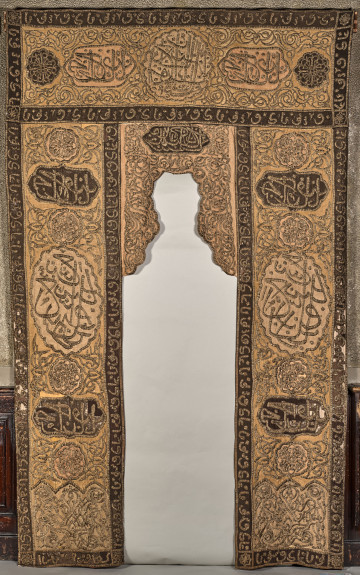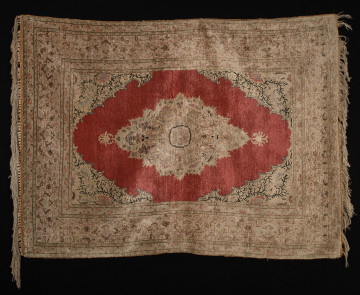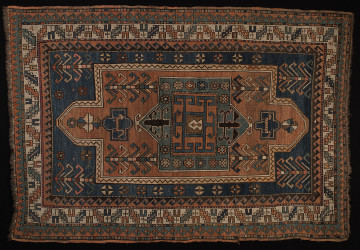
Portiere
18th-19th century
Castle Museum in Łańcut
Part of the collection: Fabrics
Rectangular silk carpet with floral and animal decoration surrounded by a six-stripe borderline of kirman type. The red-coloured background is filled to the brim with the leafy crown of the tree. In the longitudinal axis of the carpet, there is a trunk, from which branches with foliage and flowers spread out in all directions, inhabited by various species of birds. They represent peacocks and pheasants in colours similar to the shade of the surrounding plants. The whole image is surrounded by a six-stripe borderline. The widest stripe with a navy-blue background is filled with the Tree of Life motif design. Pairs of antithetically positioned animals and (heavily geometric) dragons, as well as stylised floral motifs can be found here. Ornaments in red, beige, brown and white. Narrower stripes on both sides of the main field with a background of ivory white and light beige are filled with the motif of a herat borderline (known as ‘fish pattern’) and a simplified chorasan borderline pattern. The shorter sides of the carpet are finished with long cotton fringes. Cotton warp, ‘Turkish’ knot. Kirman is not a type of thick carpet, rather a decorative one, designed for gala or living rooms. The sheen of its fine wool makes it look like it was made of silk. Central Persia, first half of the 19th century.
Dimensions
height: 300 cm, width: 200 cm
Object type
Fabrics
Technique
sewing
Material
cotton, silk (fabric)
Creation time / dating
Creation / finding place
Owner
Castle Museum in Łańcut
Identification number
Location / status

18th-19th century
Castle Museum in Łańcut

19th (?) century
Castle Museum in Łańcut

20th century
Castle Museum in Łańcut
DISCOVER this TOPIC
Castle Museum in Łańcut
DISCOVER this PATH
Educational path